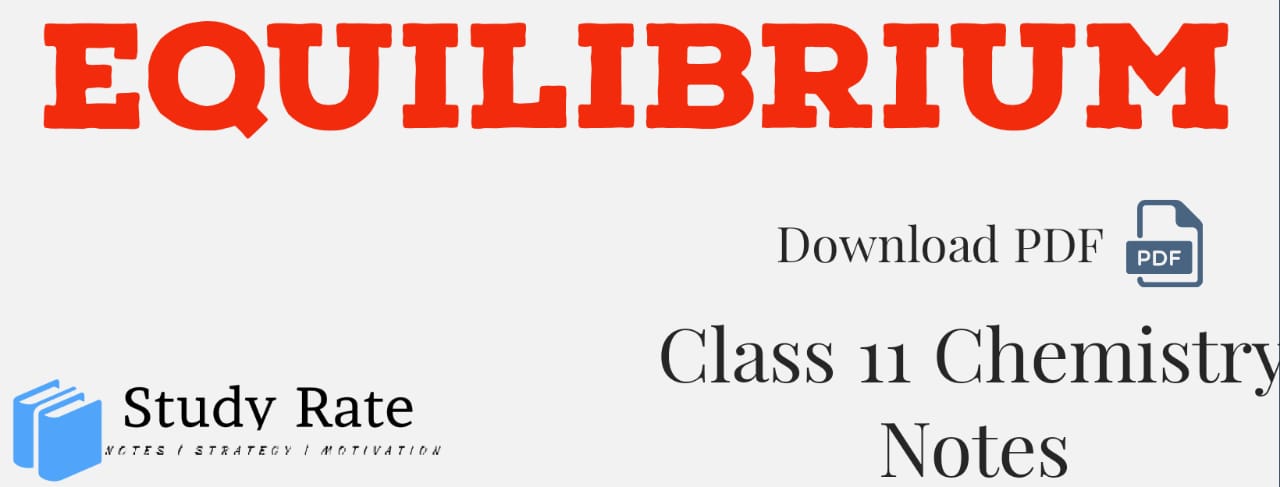Hi, in this article you will get Various types of Notes from Class 11 Chemistry Chapter 7 Equilibrium Notes for IIT-JEE and NEET, and many other competitive Exams. The Equilibrium is a Chapter 7 of the Class 11 Chemistry Book. In Class 11 Chemistry, mastering equilibrium paves the path to success in competitive exams like JEE and NEET. But, the sheer volume of information and complex equations can seem daunting.
Download Equilibrium Notes Class 11 Chemistry
Chemistry is the scientific discipline involved with elements and compounds composed of atoms, molecules, and ions: their composition, structure, properties, behavior, and the changes they undergo during a reaction with other substances.
For IIT-JEE and NEET, Equilibrium Notes in PDF on Study Rate.
| Type of Notes | Download Link |
|---|---|
| Typed Notes 1. Ionic Equilibrium 2. Chemical Equilibrium |
Download Now Download Now |
| Handwritten Notes | Download Now |
| Assignment(PYQ) 1. Ionic Equilibrium 2. Chemical Equilibrium |
Download Now Download Now |
| Revision Notes (Vedantu) | Download Now |
| NCERT Book | Download Now |
| NCERT Solutions | Download Now(Not Available) |
| ALLEN Notes | Download Now |
Navigating the Equilibrium: Key Concepts and Equations
Now, let’s delve into the key concepts and equations that govern this fascinating chemical dance:
- Law of Mass Action: This fundamental principle states that the rate of a chemical reaction is directly proportional to the product of the concentrations of the reactants raised to their stoichiometric coefficients. In simpler terms, the more reactants you have, the faster the reaction proceeds.
- Equilibrium Constant (Kc): This dimensionless constant represents the ratio of the product of the equilibrium concentrations of the products to the product of the equilibrium concentrations of the reactants. Kc tells us whether a reaction favors the reactants or the products at equilibrium. A high Kc indicates a product-favored equilibrium, while a low Kc signifies a reactant-favored equilibrium.
- Le Chatelier’s Principle: This principle states that if a system at equilibrium is subjected to a stress (change in concentration, temperature, pressure, etc.), the system will respond in a way that counteracts the stress and re-establishes equilibrium. For example, if you add more reactants, the forward reaction will be favored, consuming the added reactants and shifting the equilibrium slightly towards the products.
Beyond JEE/NEET: The Widespread Significance of Equilibrium
Equilibrium isn’t just a chapter in your textbook; it’s a principle that governs numerous natural and man-made phenomena. From the stability of ecosystems to the functioning of the human body, the concept of equilibrium plays a crucial role. Understanding it equips you not only for competitive exams but also for a deeper appreciation of the intricate balance in the world around us.
Embrace the Equilibrium Challenge: Tips for Success
Conquering equilibrium requires dedication, practice, and the right approach. Here are some tips to help you excel:
- Build a strong foundation in stoichiometry and chemical kinetics.
- Visualize the concept of equilibrium using diagrams and animations.
- Practice solving a variety of equilibrium problems with increasing difficulty.
- Seek help from teachers or mentors for any doubts or challenging concepts.
- Regularly revise your notes and key formulas.
Remember, mastery doesn’t happen overnight. Be patient, persistent, and celebrate your progress. With dedication and the right resources, you can confidently navigate the equilibrium landscape and ace your JEE/NEET preparation.



